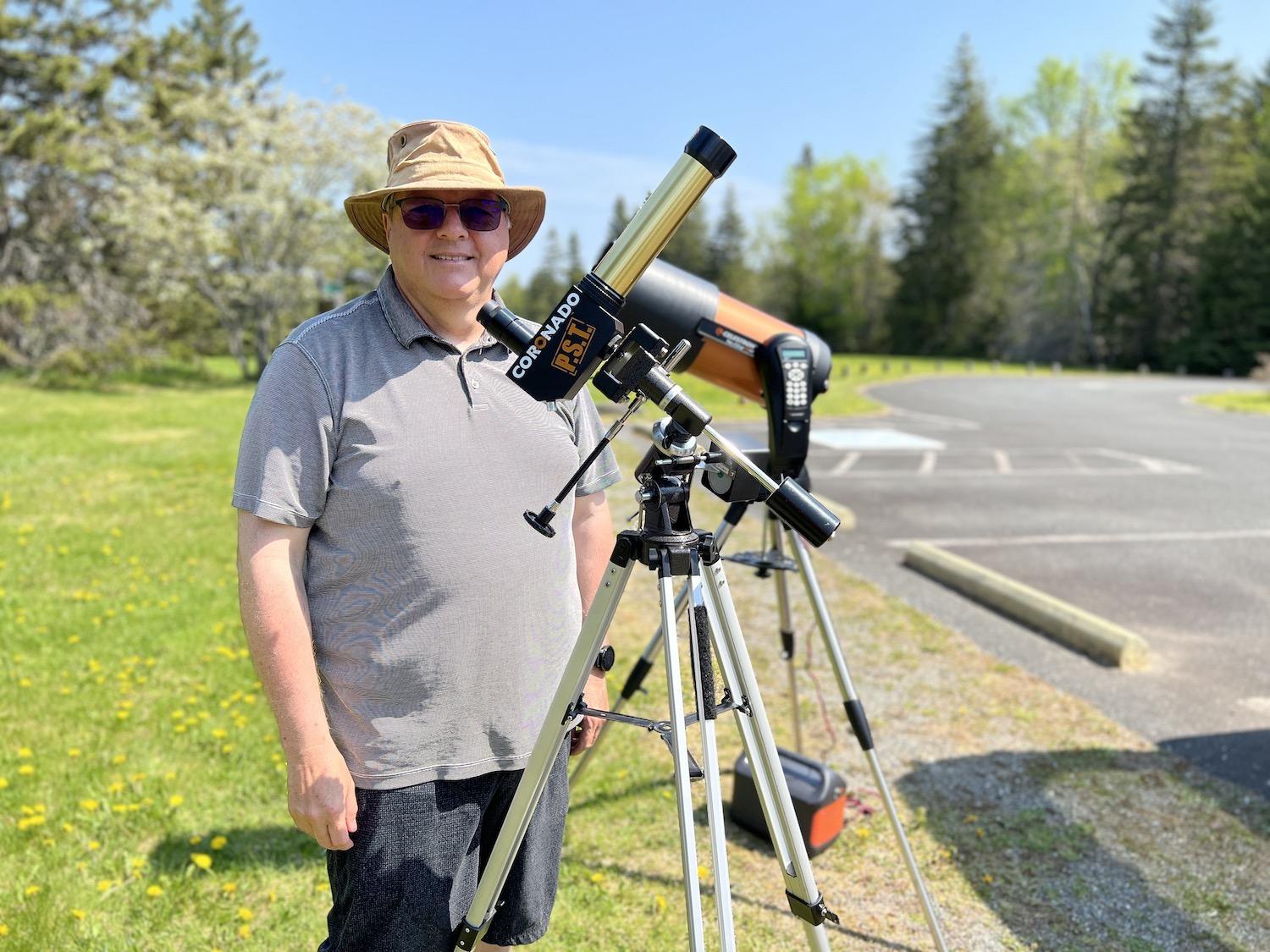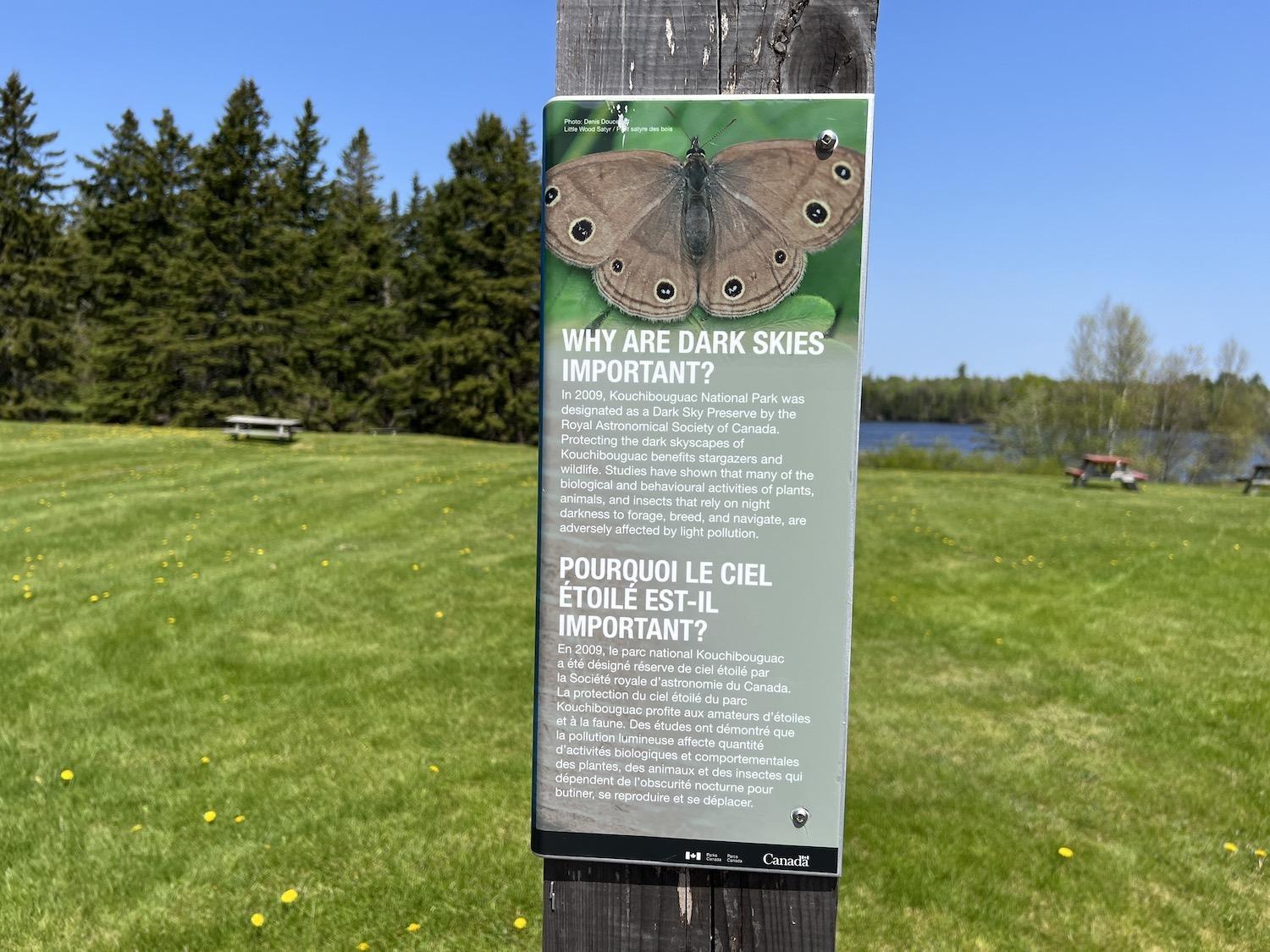
Andrew Joseph and Jillian Duplessie are resource management officers with Kouchibouguac National Park in New Brunswick/Jennifer Bain
Deep in the heart of Kouchibouguac National Park, resource management officers Jillian Duplessie and Andrew Joseph are boating along the Black River to reopen a smolt box net used to catch and study Atlantic salmon.
The net has been “closed” over the weekend so migrating fish can easily pass under it in this shallow part of a tidal river in New Brunswick. Now the plan is to open it and then return within 24 hours to taking DNA samples of the catch before safely returning the fish to the river.
It’s part of a five-year, multi-park project that’s also taking place in New Brunswick’s Fundy National Park, Nova Scotia’s Cape Breton Highlands National Park, and Newfoundland and Labrador’s Gros Morne National Park and Terra Nova National Park.

Kouchibouguac uses smelt box nets as part of its Atlantic salmon recovery project/Jennifer Bain
Duplessie is the project lead here at Kouchibouguac. Joseph, from the Elsipogtog First Nation, says “salmon in our community was a big food resource for us way back, and so for me even to work with salmon is a big bonus.”
Wild Atlantic salmon, a species of special concern in Canada, have been declining since the mid-190s, mainly because of overfishing and habitat destruction.
Each park handles the iconic species differently. Here in Kouchibouguac, staff usually catch two females and six males and transfer them to a Miramichi hatchery, and then when the time is right, remove and fertilize the eggs. The adults are released back to their home waters and the fertilized eggs are placed in special trays that are submerged in milk crates in carefully chosen streams.
Last fall, 88 adult salmon were caught, tagged and sampled for genetic analysis from four box nets installed in Black River, Rankin Brook and Kouchibouguac River.

Fertilized salmon eggs are placed in individual compartments in incubator trays with 200 cells/Jennifer Bain
After adjusting the net on this day in late May, we drive to another park spot and hike along the Black River to check on salmon incubators. Fertilized salmon eggs are placed in individual compartments in trays with 200 cells. Once the eggs hatch, the fry find a way out of the incubator and swim to the gravelly river bottom.
“We like this method because it’s ultimately less invasive than anything else we’ve seen, and there is less handling,” explains Duplessie. “There’s a 10 per cent natural survival rate. But our survival rate can be up to 70 per cent. It’s a gentle push to help boost the number of eggs hatching.”

Using a viewing bucket, Jillian Duplessie takes a look at an in-river salmon incubator/Jennifer Bain
Last fall, 12,237 Atlantic salmon eggs from two wild females were placed in these in-stream incubators in Black River and Rankin Brook. They overwintered in the streams and are expected to hatch in the summer as they would in the wild. By early summer, the crew will retrieve the incubators and count the eggs left to calculate their success rate.
Salmon spend their first two to three years in freshwater before migrating to the ocean for up to three years and then finally making their way back to their birthplace to spawn.
The salmon conservation and restoration project was first funded in 2019 for five years. The parks are hoping to land another five years of funding.
Visitors to Kouchibouguac aren’t likely to see salmon, but they can read about the project online and learn more by talking to staff.

Kouchibouguac National Park is an official Dark Sky Preserve/Parks Canada, Nigel Fearon Photography
The park is also getting ready for Apr. 8, 2024. That’s the day that the total solar eclipse is set to cross North America for a few precious hours. It will enter Canada through Ontario after lunch and travel east before exiting in Newfoundland just before dinner.
Everybody from Mexico to the United States to Canada is jockeying for a slice of eclipse tourism and New Brunswick is set be a prime viewing spot as the moon goes between the Earth and sun.
“Basically, it will get dark in the daytime,” explains Yvon Hachey, a volunteer member of the New Brunswick Centre chapter of the Royal Astronomical Society of Canada (RASC). “It happens every year but it doesn’t always happen where there’s people. Sometimes it’s over an ocean.”

Yvon Hachey, a volunteer member of RASC's New Brunswick Centre chapter, brings his telescope to Kouchibouguac National Park/Jennifer Bain
Everything is weather permitting, of course. “We have a saying in astronomy that the best place for astronomy is the place with no clouds,” cautions Hachey. As well, safety is key when it comes to an eclipse, when you can seriously damage your eyes by looking straight at the sun. The province will hand out disposable eclipse viewers with solar filters.
He meets me at a Kouchibouguac picnic spot called La Source and brought along some gear. “Do you want to start with the sun and have a peak?” he asks. “A lot of people think we only do things at night but we do lots of things in the day.”
Looking through his solar telescope, I saw an orange ball with white streaks on one side (solar flares) and a sunspot in another area. “It’s actually very active,” says Hachey, pulling out his astronomy observing log.

At a picnic spot called La Source in Kouchibouguac, interpretive signs promote the park's dark skies/Jennifer Bain
RASC designated Kouchibouguac a dark-sky preserve in 2009. As the park puts it, the lighting of modern urban areas has nearly eliminated the “natural glory of the night sky,” which many people now see only when they’re vacationing in the “great outdoors.”
Dark sky preserves reduce light levels that hinder viewing the night sky. Protecting the dark skyscapes benefits not just stargazers, but wildlife. Studies have shown that light pollution harms many of the biological and behavioural activities of plants, animals and insects that rely on night darkness to forage, breed and navigate.
“We all need the dark,” one of the park’s interpretive signs proclaims.

Visitors might not even notice dark-sky friendly solar panel lights in Kouchibouguac/Jennifer Bain
The park renovated various buildings and replaced regular lighting with low intensity alternatives, like pot lights and down lighting fixtures with amber-colored lights. It hosts dark sky activities. Some of the best spots in the park for dark sky viewing are La Source, Callanders Beach (near the wigwam), Kellys Beach (on or past the boardwalk) and the semi-primitive Côte-À-Fabien campground.
I visit Kouchibouguac in May, spending two nights just outside the park gate at L’Ancrage Bed & Breakfast & Cottages, where I keep a close eye on the night sky. Alas, it’s too cloudy to see anything and so I don’t wind up venturing to the park’s viewing point at night. If there’s one thing I’ve learned when trying to do dark sky viewing at parks across Canada, it’s that you can’t be in a rush and need to book multiple nights to boost your chance of success.

Don Kelly stands before the William Brydone Jack Observatory on the University of New Brunswick campus in Fredericton/Jennifer Bain
While we’re on the subject of the sky, I flew into Fredericton to get to Kouchibouguac. That’s where Don Kelly — a founding member of the William Brydone Jack Astronomy Club in Fredericton — shows me the oldest existing astronomical observatory in Canada.
The William Brydone Jack Observatory was built in 1851 on the University of New Brunswick campus. Jack, while he was the university president, helped establish the correct longitude of Fredericton and several other sites in New Brunswick, and corrected errors in the international boundary. His measurements were used for the first map of the province. A copy of that map plus the custom, 7.5-foot-long achromatic telescope from 1849 are displayed in the observatory.

 Support Essential Coverage of Essential Places
Support Essential Coverage of Essential Places



